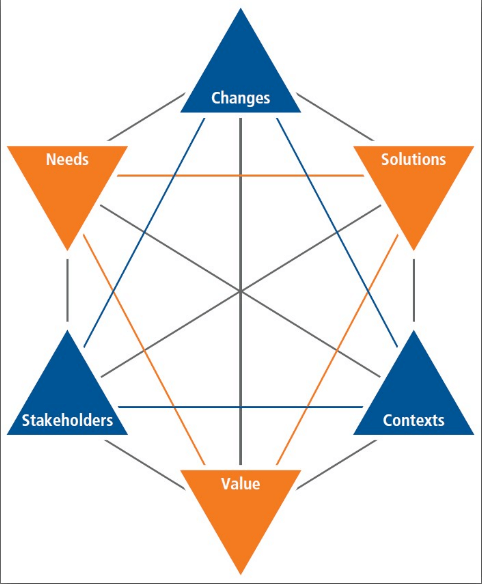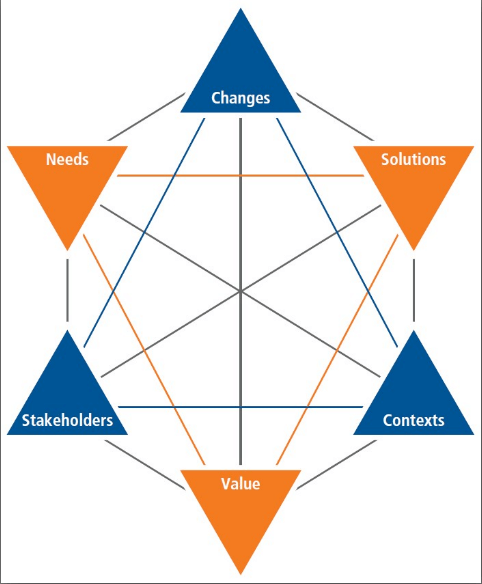7 Trends in Business Analysis, Project Management, and Agile
Each year since 2009 we have enjoyed reflecting on what’s happened the previous year in the areas of business analysis and project management (including Agile), and making predictions for the upcoming year. To summarize the trends we saw in 2015:
- Focus on entrepreneurship and innovation, including distributed leadership and the rise of intrapreneurs. This is still hot, hot, hot, but innovation for innovation’s sake is not.
- Challenges with Agile adoption. For new challenges, read on.
- What we called a schizophrenic approach to certifications. To learn about what’s happening with certifications, read on.
- Use of designs during analysis. This was a new concept last year. To understand why it is still important, read on.
- Struggle with how much requirements management governance is enough.
Here are the industry trends we see happening for the upcoming year.
1. Proving our value through Business Relationship Management
Executives have long been interested in getting the most value from programs and projects. They want initiatives that show true commitment to value realization. This need is one reason for the increased popularity of Agile. A new trend that is also helping ensure that value is achieved is the emergence of the business relationship manager (BRM) role. BRMs are more than just liaisons between business and IT. They propose and help influence the portfolios, programs, and projects that will deliver the most value. The role is accountable not only for delivering value but also for proving it.
We think this role will begin to gain popularity because too often the responsibility for measuring value has fallen into the chasm between business units and service providers, meaning no one focuses on it. BRMs fill that void, for example, by linking the actual benefits received from an initiative back to the forecasted benefits in a business case. This feedback loop greatly improves initial forecasts, project selection, and leads to quicker decisions to abandon projects that aren’t delivering sufficient value.
2. Agile is gaining wide acceptance but still faces challenges
As Agile practices gain traction in some organizations and mature in others, some significant questions still remain including:
- Is everyone on board? For example, some executives want Agile without understanding the organizational commitment and cultural changes required. Some executives are on board, as are the Agile teams, but mid-management resists. Sometimes Agile is successfully adopted by the IT organization, but not by other stakeholders. With this mismatch in acceptance comes a mismatch in expectations that will need to be addressed.
- Can teams be truly cross-functional? Organizations often struggle with how to incorporate roles that do not clearly fit into one of the Scrum roles of scrum master, product owner, or development team member. Some have found it hard for all team members to effectively do more traditional “specialized” roles like UI/UX, database analyst, business analyst, tester, etc.
- How much governance should the team follow? Teams are still struggling with such things as how to measure velocity and the associated need for metrics, how much planning is needed, and the age-old how much documentation is enough.
- Can partial adoption work? We hear client stories about not having time for retrospectives, daily standups, and other ceremonies. Referred to by names such as Scrumerfall and Waterscrum, these methods have both supporters and detractors.
We believe that although these issues will not be solved in the upcoming year, they will be addressed.
3. Moving beyond our traditional PM and BA roles
Traditionally, Business Analysts have “gathered and managed” requirements and Project Managers have managed a project’s time, budget, and scope. The future is looking very different. The same responsibilities will be needed, but they will be augmented with strategic-oriented duties. Organizations increasingly realize they need to ensure projects actually deliver the benefit value that was stated in the business case. Smart organizations are deploying project professionals more strategically to help them obtain and prove the increased value, including new roles that go beyond the traditional BA and PM (see trend #1).
- Project Managers are increasingly focused on delivering the benefits and value outlined in the business case and program charter. Plus, there is a growing trend of aligning projects to the strategic initiatives of the organization.
- Business Analysts who can question the strategic implications of projects and facilitate understanding the real business need behind stated needs are providing increased value to the organization and its customers.
This trend is good news for project managers and business analysts who like to think and contribute strategically.
4. Lightweight practices are not just for Scrum anymore
Project Managers and others really are finally making peace with the idea that delivering value is what matters, not whether or not they’re Agile and how Agile are they. Yes, people still struggle with organizational change issues around implementing Agile, and yes, team members aren’t always given what they need to make the switch effectively. But the angst increasingly is no longer about whether organizations or teams can call ourselves Agile; it’s (appropriately) about whether what they’re doing benefits the organization, particularly when they’re doing more than is really needed. If doing the right amount of work for the organization manifests itself in some kind of light-weight, Agile-traditional combo practices, then organizations are becoming more OK with that, as long as it delivers value fast and eliminates waste. This is happening outside the boundaries of projects, as well. Whether it’s HR decreasing the frequency of, or even eliminating, regular performance reviews, or organizational metrics around customer or employee satisfaction getting culled back to scales of 1-3 or simply yes/no, it’s not that less is more. Less is the norm.
5. Certifications – and the winners are. . . .
As predicted a year ago, there is still no clarity related to industry certifications. There are some changes, though.
- Some certifications, once popular in limited geographic locations, are growing significantly. For example, the number of PRINCE2 exams taken in the US grew by 35% in 2015. IREB (International Requirements Management Board) is also gaining momentum.
- Despite the predicted demise of associations like PMI and IIBA, both are still here, both are emphasizing business analysis, and both are trying to broaden their reach. IIBA is offering four levels of certifications and PMI not only has a business analysis certification but is currently working on a full business analysis standard.
As a side note and cautionary tale, the Harvard Business Review recently posted an article about the need for all professional associations, not just those related to project management and business analysis, to rebrand, as members find alternate ways to network and learn.
6. Designs during analysis bring business value quicker
As we predicted last year, the increasing use of business analysis techniques for “non-technical” design work is gaining momentum. This approach is similar to design thinking and moves the focus from product requirements to product features and functions. This trend is popular because it leverages tried and true methods for understanding customer needs and gets them into a buildable solution quicker.
Here are some examples of “non-technical” designs. Instead of listing data requirements in a simple data dictionary, the trend is to create a fully normalized data model. Instead of creating a use case narrative that must be transformed into other objects, the trend is to create them in the form of readily useful acceptance criteria. Instead of ignoring user interfaces, the trend is to create prototypes that reflect business needs. Each of these helps create the solution sooner, thereby helping the organization achieve maximum value sooner.
7. Workforce Trends are Impacting Project Work and Organizations.
There are a number of trends related to how organizations get work done.
- There is an increasing comfort level using Skype, IM, and other tools for impromptu, short communications outside the context of actual meetings. Because communication is increasingly becoming less formal and more frequent, we are starting to reclaim some of the connectedness we recently lost working virtually. Engaging stakeholders virtually is also becoming more doable with the online tools.
- To address the preferences of many younger workers, learning events are becoming shorter and more personalized by incorporating the array of digital learning tools now available. Personalized learning environments are providing workers with an opportunity to think in new ways and continually learn as they adjust and adapt to new technology and evolving processes.
- Organizations are beginning to adjust to the fact that many workers are not interested in staying in one job for any length of time. This includes not only younger workers but older workers who are looking to expand their skills in the second-half of their work lives. This will increasingly present a challenge to organizations and projects at risk of losing both younger and older workers with valuable knowledge and experience.
[i] Harvard Rusiness Review, To Stay Relevant, Professional Associations Must Rebrand by Denise Lee Yohn https://hbr.org/2016/01/to-stay-relevant-professional-associations-must-rebrand, January 5. 2-16. viewed on January 13, 2016.
About the Authors
Andrea Brockmeier, PMP, CSM, PMI-ACP, is the Director of Project Management at Watermark Learning. She has 20+ years of experience in project management and related practice and training. She writes and teaches courses in project management, business analysis, and influencing skills. She has long been involved with the PMI® chapter in Minnesota where she is a member of the certification team. She has a master’s degree in cultural anthropology and is particularly interested in the cultural aspects of team development, as well as the impact of social media and new technologies on organizations and projects.
Elizabeth Larson, PMP, CBAP, CSM, PMI-PBA is Co-Principal and CEO of Watermark Learning and has over 30 years of experience in project management and business analysis. Elizabeth’s speaking history includes repeat presentations for national and international conferences on five continents.
Elizabeth has co-authored five books on business analysis and certification preparation. She has also co-authored chapters published in four separate books. Elizabeth was a lead author on several standards including the PMBOK® Guide, BABOK® Guide, and PMI’s Business Analysis for Practitioners – A Practice Guide.
Richard Larson, PMP, CBAP, PMI-PBA, President and Founder of Watermark Learning, is a successful entrepreneur with over 30 years of experience in business analysis, project management, training, and consulting. He has presented workshops and seminars on business analysis and project management topics to over 10,000 participants on five different continents.
Rich loves to combine industry best practices with a practical approach and has contributed to those practices through numerous speaking sessions around the world. He has also worked on the BA Body of Knowledge versions 1.6-3.0, the PMI BA Practice Guide, and the PM Body of Knowledge, 4th edition. He and his wife Elizabeth Larson have co-authored five books on business analysis and certification preparation.
Susan Heidorn, PMP, CBAP, Ed.D, CSM, is the Director of Business Solutions at Watermark Learning. Susan Heidorn is an experienced consultant, facilitator, speaker, and trainer, with over twenty years of business experience. She provides project and program management, strategic thinking & planning, leadership development, business analysis, facilitation, process improvement, change management, and team development to her clients based on best practices in the industry.


 Figure 1: Business Analysis Core Concept Model
Figure 1: Business Analysis Core Concept Model

